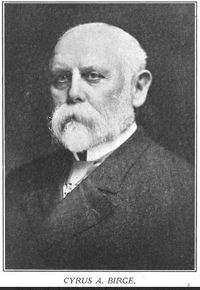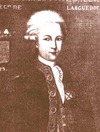
Source: Link
BIRGE, CYRUS ALBERT, merchant, accountant, and industrialist; b. 7 Nov. 1847 in Trafalgar Township, Upper Canada, son of Herman P. Birge and Helen M. Ainslie, farmers; m. first 30 Aug. 1870 Rebecca Jane Coote (d. 1898) in Oakville, Ont., and they had a son and a daughter; m. secondly 19 Feb. 1902 Margaret Vanstone (d. 1904) in Wingham, Ont., and they had a son; m. thirdly 1908 Mabel I. Sturt of Brooklyn (New York City); d. 14 Dec. 1929 in Hamilton, Ont.
Cyrus Birge’s father came from Hartford, Conn., about 1840 and settled in the Oakville area; in 1842 he married Helen Ainslie of nearby Nelson Township. Despite his father’s death in 1855, Cyrus was able to spend several years at local schools, including the Oakville Grammar School. At age 18 he started to learn the dry-goods business but three years later he decided to enrol in medicine at Victoria College in Cobourg. After only a year, ill health prompted him to return to Oakville, where he worked for a dry-goods merchant. He opened his own grocery store in Stratford in 1870, and then one in Chatham. Two years later he joined the Great Western Railway as an accountant in its engineering department. Initially he worked in Hamilton but he also spent some time in London. In 1882 he left to become manager of the Canada Screw Company, a financially troubled firm in Dundas that had been purchased in 1876 by the American Screw Company of Providence, R.I. Birge put the firm back on its feet. As part of the trend to use female labour in factories, it hired young women to run new American screw-making machinery. In 1883 Birge formed a partnership with American industrialist Charles Alexander to operate the factory, which was coaxed with tax incentives to move to Hamilton in 1887. Birge was vice-president and managing director from 1883 to 1898, when he bought out the American investors and became president. In 1907 his company merged with another large Hamilton operation, the Ontario Tack Company, which had also been started by American investors. The new company, which kept the name Canada Screw and Birge as president, moved to a large, technologically sophisticated plant in Hamilton’s growing industrial east end.
Birge’s interest in the iron industry had already brought him into another important project. In 1895 he and a group of other local businessmen, including Andrew Trew Wood*, William Southam*, John Henry Tilden, and John Milne, established the Hamilton Blast Furnace Company Limited to take over the smelting operations of the Hamilton Iron and Steel Company Limited, which had been incorporated in 1893 but had been hit by extreme depression in the iron trade. Birge served on the board of Hamilton Blast Furnace until a union in 1899 with the Ontario Rolling Mills Company, also of Hamilton, created the Hamilton Steel and Iron Company Limited. In 1910 a much larger merger brought together iron and steel plants across central Canada (Birge’s Canada Screw, Hamilton Steel and Iron, Montreal Rolling Mills, Canada Bolt and Nut of Toronto) to create the Canadian Steel Corporation Limited. Immediately renamed the Steel Company of Canada Limited [see Wilmot Deloui Matthews*], it would eventually include Dominion Wire Manufacturing of Montreal as well. Though Birge was close to retirement, he had participated in the negotiations and his substantial capital in the new venture brought him the position of vice-president. However, he took no active part in the new firm’s operations, which were left largely in the hands of Robert Hobson.
By this point Birge had become a respected member of the Hamilton business community. The Bank of Hamilton made him a director in 1904, vice-president in 1914, and president in 1923, the year it merged with the Canadian Bank of Commerce. He was then added to its board of directors. As president of the local Mercantile Trust Company, he presided over its merger with National Trust a year later. In the tight network of overlapping directorships in Hamilton industries, Birge had also joined the boards of several other firms, including Sawyer-Massey in 1910, Hamilton Stove and Heater (as vice-president) in 1913, and Dominion Power and Transmission (as vice-president) in 1916. Like several other local businessmen, he had connections and investments that extended beyond Hamilton. He was president of Sovereign Fire Insurance, vice-president of Turbine Steamship, and a director of British American Oil, Chinook Coal, and Lake of the Woods Milling. As befitted such involvement, he was a member of the boards of trade of both Hamilton and Toronto, and in 1903 he was a Canadian delegate to the Fifth Congress of Chambers of Commerce of the Empire in Montreal.
Brusque and opinionated, Birge had also taken a leadership role in the broader business community. He had been a member of the Canadian Manufacturers’ Association for some 20 years and an executive member before the association undertook a complete reorganization in 1900 to make it a more effective lobbying force. Birge must have played a prominent role in this reconstruction since he was chosen as vice-president for Ontario in 1900, national vice-president in 1901, and president in 1902. In these capacities he was expected to promote the interests of manufacturers in the all-important areas of tariff, transportation policy, and industrial relations. During his term as president the CMA followed the recommendation of a special committee and struck a vigorous anti-union stance, specifically directed against any pro-labour legislation. In his presidential address of 1903 Birge proclaimed that the employer “must be free to purchase without interference such labor as he requires” and attacked the growing links between Canadian unions and their American counterparts. In subsequent years, he served on the CMA’s important tariff committee. When a branch of the CMA was organized in Hamilton in 1909, he joined its executive, and in 1912-13 he served as chair.
Birge was a staunch Methodist who believed that a business leader should take an active role in the organizational life of his church. At Hamilton’s Wesley Methodist Church, he was Sunday school superintendent for 17 years and a steward and trustee for 28. He also attended the General Conference of the Methodist Church of Canada and served on its church union committee. Yet he became uncomfortable with the progressive Social Gospel movement that was percolating through this church early in the 20th century. At the General Conference of October 1918, in Hamilton, he was one of only four delegates to oppose a report calling for the shift of economic life “from a basis of competition and profits to one of co-operation and service.” He was more comfortable with paternalistic charity. In 1907 he had donated $50,000 to Victoria University in Toronto to match the sum American industrialist Andrew Carnegie had provided to endow its library. In 1915 he became chair of Hamilton’s branch of the Canadian Patriotic Fund, set up to provide for wives and children of men serving in the armed forces, and he later sat on the organization’s national executive.
Birge belonged to two mass-membership fraternal societies, the Oddfellows and the Ancient Order United Workmen, but his wealth and powerful connections gave him access to a more exclusive world of private recreation. With other upper-class men, he retired to the Hamilton, National, and Toronto clubs; for outdoor sports, he frequented the Caledon Mountain Trout, the Tamahaac, and the Hamilton Golf and Country clubs. He died suddenly on 14 Dec. 1929.
Cyrus Birge had risen from relatively modest rural roots to prominence in southern Ontario business circles. His success no doubt rested on managerial skills learned inside a large railway corporation, entrepreneurial abilities acquired in the late-19th-century wave of industrialization, and participation in the collaborative projects of fellow capitalists in Hamilton who marshalled the resources needed to create mass production. In this new era, Birge became a more passive, but still respected investor, whose great wealth brought him onto many corporate boards and whose Methodist faith propelled him toward a life of public service.
AO, RG 80-5-0-7, liber 6, f.108; RG 80-5-0-302, no.9193. LAC, MG 28, I 230, 16: 1909-10, 1912-13. Hamilton Spectator (Hamilton, Ont.), 14 Nov., 14 Dec. 1895; 14 Dec. 1929. Richard Allen, The social passion: religion and social reform in Canada, 1914-28 (Toronto, 1971; repr. 1990). Annual financial rev. (Toronto and Montreal), 1904: 54; 1908: 60; 1910: 26; 1914: 98; 1916: 404; 1923: 114. Can., Statutes, 1896, c.48. Canada Gazette, 11 June 1910: 3900; 25 June 1910: 4129. Canadian annual rev., 1902-28/29. Canadian Engineer (Toronto and Montreal), 7 (1899-1900): 141. Canadian history makers . . . (Montreal, 1913). Canadian Machinery and Manufacturing News (Toronto), 11 (January-June 1914): 92. Canadian men and women of the time (Morgan; 1912). Canadian Mining Rev. (Ottawa), 14 (1895): 82. Canadian Patriotic Fund, Hamilton and Wentworth Branch, Five years of service, 1914-1918 ([Hamilton?, 1920?]). S. D. Clark, The Canadian Manufacturers’ Association: a study in collective bargaining and political pressure (Toronto, 1939). Directory of directors (London, Eng.), 1912, pt.i, 25. Encyclopaedia of Canadian biography . . . , vol.2. Industrial Canada (Toronto), 4 (1903-4): 111; 5 (1904-5): 328; 6 (1905-6): 204-6; 7 (1906-7): 266-68. Iron Age (New York), 61 (January-June 1898): 12. William Kilbourn, The elements combined: a history of the Steel Company of Canada (Toronto and Vancouver, 1960), 42-43, 59, 71-73, 75. Newspaper reference book. Ont., Statutes, 1895, c.67; 1896, c.80. Victor Ross and A. St L. Trigge, A history of the Canadian Bank of Commerce, with an account of the other banks which now form part of its organization (3v., Toronto, 1920-34), 3. Who’s who and why, 1921.
© 2005–2024 University of Toronto/Université Laval
Image Gallery

Cite This Article
Craig Heron, “BIRGE, CYRUS ALBERT,” in Dictionary of Canadian Biography, vol. 15, University of Toronto/Université Laval, 2003–, accessed April 26, 2024, http://www.biographi.ca/en/bio/birge_cyrus_albert_15E.html.
The citation above shows the format for footnotes and endnotes according to the Chicago manual of style (16th edition). Information to be used in other citation formats:
| Permalink: | http://www.biographi.ca/en/bio/birge_cyrus_albert_15E.html |
| Author of Article: | Craig Heron |
| Title of Article: | BIRGE, CYRUS ALBERT |
| Publication Name: | Dictionary of Canadian Biography, vol. 15 |
| Publisher: | University of Toronto/Université Laval |
| Year of publication: | 2005 |
| Year of revision: | 2005 |
| Access Date: | April 26, 2024 |










